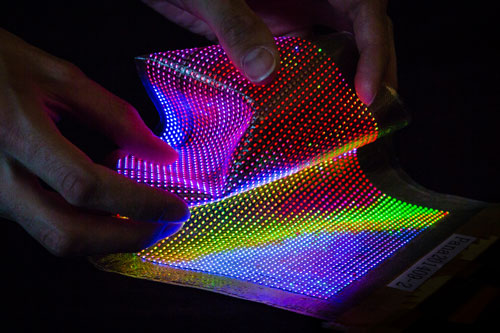| Posted: Sep 02, 2015 |
Turning clothing into information displays
(Nanowerk News) Researchers from Holst Centre (set up by TNO and imec), imec and CMST, imec’s associated lab at Ghent University, have demonstrated the world’s first stretchable and conformable thin-film transistor (TFT) driven LED display laminated into textiles. This paves the way to wearable displays in clothing providing users with feedback.
|
 |
| The world’s first stretchable and conformable thin-film transistor (TFT) driven LED display laminated into textiles developed by Holst Centre, imec and CSMT. (click on image to enlarge)
|
|
Wearable devices such as healthcare monitors and activity trackers are now a part of everyday life for many people. Today’s wearables are separate devices that users must remember to wear. The next step forward will be to integrate these devices into our clothing. Doing so will make wearable devices less obtrusive and more comfortable, encouraging people to use them more regularly and, hence, increasing the quality of data collected. A key step towards realizing wearable devices in clothing is creating displays that can be integrated into textiles to allow interaction with the wearer.
|
|
“Wearable devices allow people to monitor their fitness and health so they can live full and active lives for longer. But to maximize the benefits wearables can offer, they need to be able to provide feedback on what users are doing as well as measuring it. By combining imec’s patented stretch technology with our expertise in active-matrix backplanes and integrating electronics into fabrics, we’ve taken a giant step towards that possibility,” says Edsger Smits, Senior research scientist at Holst Centre.
|
|
The conformable display is very thin and mechanically stretchable. A fine-grain version of the proven meander interconnect technology was developed by the CMST lab at Ghent University and Holst Centre to link standard (rigid) LEDs into a flexible and stretchable display. The LED displays are fabricated on a polyimide substrate and encapsulated in rubber, allowing the displays to be laminated in to textiles that can be washed. Importantly, the technology uses fabrication steps that are known to the manufacturing industry, enabling rapid industrialization.
|
|
Following an initial demonstration at the Society for Information Display’s Display Week in San Jose, USA earlier this year, Holst Centre has presented the next generation of the display at the International Meeting on Information Display (IMID) in Daegu, Korea, 18-21 August 2015. Smaller LEDs are now mounted on an amorphous indium-gallium-zinc oxide (a-IGZO) TFT backplane that employs a two-transistor and one capacitor (2T-1C) pixel engine to drive the LEDs. These second-generation displays offer higher pitch and increased, average brightness. The presentation will feature a 32x32 pixel demonstrator with a resolution of 13 pixels per inch (ppi) and average brightness above 200 candelas per square meter (cd/m2). Work is ongoing to further industrialize this technology.
|

